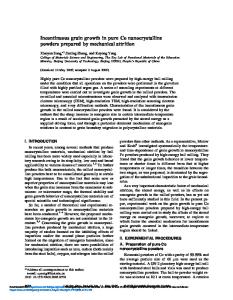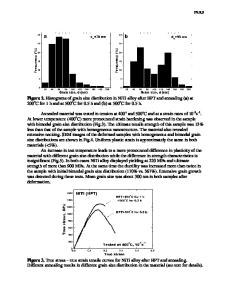Mechanical properties, ductility, and grain size of nanocrystalline iron produced by mechanical attrition
- PDF / 989,729 Bytes
- 11 Pages / 612 x 792 pts (letter) Page_size
- 7 Downloads / 347 Views
I.
INTRODUCTION
The potential use of nanocrystalline (nc) materials in structural applications stems from the prospect of hardening polycrystalline materials through the refinement of their grain size.[1,2,3] This prospect made the mechanical properties of nc materials one of the active research areas.[4,5,6] One often asked question is whether the properties of nc materials can simply be predicted by extrapolating down to the nanometer size range established structure-property relationships for the coarse-grained regime. Regarding the mechanical properties, the most referred-to relationship in investigations of nc materials is the empirically established Hall–Petch equation. It relates the stress s (yield stress, flow stress, hardness, or fracture stress) to the grain size, d, s 5 so 1 k
1 =d
[1]
where s0 and k are experimental constants with varying interpretations.[7–10] Mechanical attrition, like many other physical and chemical processing routes to obtain nc/nanophase materials, results in powders. Powders are not a practical form for most mechanical testing methods. The only technique that readily provides data from small sample volumes is the microhardness test, which consequently was extensively used to characterize the mechanical behavior of nc materials. It is thus desirable to consolidate the powders into bulk samples. The consolidation is usually achieved through the application of a combination of temperature and pressure to the powder. The application of temperature will possibly lead to the coarsening of the grain structure,
T.R. MALOW, Research Assistant, and C.C. KOCH, Professor, are with the Department of Materials Science and Engineering, North Carolina State University, Raleigh, NC 27695-7907. This article is based on a presentation made in the symposium ‘‘Mechanical Behavior of Bulk Nanocrystalline Solids,’’ presented at the 1997 Fall TMS Meeting and Materials Week, September 14–18, 1997, in Indianapolis, Indiana, under the auspices of the Mechanical Metallurgy (SMD), Powder Materials (MDMD), and Chemistry and Physics of Materials (EMPMD/SMD) Committees. METALLURGICAL AND MATERIALS TRANSACTIONS A
and the nc structure could be lost if the consolidation parameters are not chosen appropriately. The knowledge of the thermal stability of nc materials is, therefore, necessary for the successful consolidation of the powders while retaining an nc structure. So far, the main conclusions of investigations on the mechanical properties of nc metallic and ceramic systems are that grain refinement causes hardening, sometimes dramatic, with a Hall–Petch-type relationship.[4,5] In several instances, the slope in the Hall–Petch plot was reported to decrease toward zero or even to negative values for the smallest investigated nc grain sizes, which could be attributed to artifacts.[11,12,13] In this study, the consolidation of mechanically attritted nc iron powder was investigated as a function of pressure and temperature. The hardness measurements of the compacts are discussed in conjunction with results of
Data Loading...











